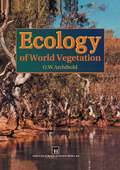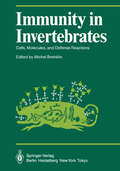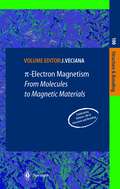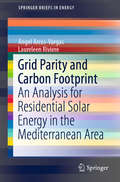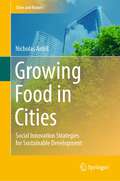- Table View
- List View
Ecology of World Vegetation
by O.W. ArchiboldThe ecology of world vegetation is described in numer all of the drafting and photographic work. They have ous books and journals, but these are usually very spe spent many hours on this project and their care and skill cialized in their scope and treatment. This book provides is reflected in the consistently high quality of the illus a synthesis of this literature. A brief introductory chap trations throughout the book. Many friends and col ter outlines general ecological concepts and subsequent leagues have provided photographs. It has not been chapters examine the form and function of the major possible to include all of them, but the 'global' perspect biomes of the world. A similar organization has been ive of the book has been greatly enhanced in this way. used for each biome type. These chapters begin with a I wish to thank them all for the time and trouble they description of environmental conditions and a brief have taken to supply this material. I must also thank account of floristic diversity in a regional context. The Mary Dykes and the staff of the interlibrary loans de remaining pages describe characteristic adaptations and partment of the Library, University of Saskatchewan, ecosystem processes. for their unfailing ability to get even the most obscure Although there is a rapidly growing literature on eco references.
Nonlinear Systems, Vol. 2: Nonlinear Phenomena in Biology, Optics and Condensed Matter (Understanding Complex Systems)
by Juan F. Archilla Faustino Palmero M. Carmen Lemos Bernardo Sánchez-Rey Jesús Casado-PascualThis book presents an overview of the most recent advances in nonlinear science. It provides a unified view of nonlinear properties in many different systems and highlights many new developments.While volume 1 concentrates on mathematical theory and computational techniques and challenges, which are essential for the study of nonlinear science, this second volume deals with nonlinear excitations in several fields. These excitations can be localized and transport energy and matter in the form of breathers, solitons, kinks or quodons with very different characteristics, which are discussed in the book. They can also transport electric charge, in which case they are known as polarobreathers or solectrons. Nonlinear excitations can influence function and structure in biology, as for example, protein folding. In crystals and other condensed matter, they can modify transport properties, reaction kinetics and interact with defects. There are also engineering applications in electric lattices, Josephson junction arrays, waveguide arrays, photonic crystals and optical fibers. Nonlinear excitations are inherent to Bose-Einstein Condensates, constituting an excellent benchmark for testing their properties and providing a pathway for future discoveries in fundamental physics.
Ecosystem Services and Green Infrastructure: Perspectives from Spatial Planning in Italy (Cities and Nature)
by Andrea Arcidiacono Silvia RonchiThe book analyses the relationship between ecosystem services, green and blue infrastructures (GBI) and spatial planning in Italy. It provides insights on the opportunities and challenges in the adoption of an ecosystem services (ES)-based approach for Spatial Planning exploring methods and techniques for the design of GBI strategies. Nowadays, there is an advance in ES knowledge and a recognition of the benefits of GBI for the quality of human life and biodiversity conservation. The main challenge remains how this knowledge could be integrated into the planning process and how it could guide the decision-making process towards sustainable development for contemporary cities. The book collects innovative Italian experiences providing important considerations for operationalizing the ES concept and highlighting different disciplinary attitudes and methodological approaches with the common goal to enhance human well-being.
Immunity in Invertebrates: Cells, Molecules, and Defense Reactions (Proceedings in Life Sciences)
by J. M. Arcier N. Boemare J. R. Bonami C. P. Vivaresπ-Electron Magnetism: From Molecules to Magnetic Materials (Structure and Bonding #100)
by D. Arcon M. Deumal K. Inoue M. Kinoshita J. J. Novoa F. Palacio K. Prassides J. M. Rawson C. RoviraCelebrating Volume 100: Thirty years ago Springer-Verlag together with a distinguished Board of Editors started the series Structure and Bonding. Initially the series was set up to publish reviews from different fields of modern inorganic chemistry, chemical physics and biochemistry, where the general subject of chemical bonding involves a metal and a small number of associated atoms. Three years ago the aims of the series was refined to span the entire periodic table and address structure and bonding issues wherever they may be relevant. Not only the traditional areas of chemical bonding will be dealt with but also nanostructres, molecular electronics, supramolecular structure, surfaces and clusters. With these aims in mind it is noteworthy that Volume 100 effectively reinforces and illustrates these ideals and is titled Pi-Electron Magnetism from Molecules to Magnetic Materials.
The Role of the Electric Vehicle in the Energy Transition: A Multidimensional Approach (Green Energy and Technology)
by Angel Arcos-VargasThis book explores the part that electric vehicles can play in reducing carbon dioxide emissions. Further, it explains the impact of public support, technological advances, lower costs and better battery performance in making electric vehicles a viable alternative. The book begins by analyzing the international context of electric vehicles and how they are being developed in different countries, and by offering a forecast of the electricity demand they may create. It then discusses technological innovations in electric vehicle recharging systems. The book is concerned not only with the economic potential of electric vehicles, but also with environmental aspects; consequently, it examines the raw materials supply chain and performs a lifecycle assessment. The book concludes with a chapter on alternative energies in transport, which may also help to facilitate the energy transition. Given its scope, the book offers a valuable resource for researchers, graduate students, policymakers and industry professionals interested in the energy transition and transport.
Grid Parity and Carbon Footprint: An Analysis for Residential Solar Energy in the Mediterranean Area (SpringerBriefs in Energy)
by Ángel Arcos-Vargas Laureleen RiviereThis book analyses the economic and environmental aspects of installing photovoltaic facilities for residential electricity users and determines whether the installation of photovoltaic units “behind the meter” makes sense, and if so, the best economic size to install. It explores the use of photovoltaic capacity to meet electricity requirements by generating enough for immediate use without feeding surplus electricity into the grid and without using storage. The authors illustrate this approach by examining various power photovoltaic capacities in locations such as Marseille, Madrid and Seville, which use hourly demand data provided by smart meters. They also show the possibility of developing energy self-consumption compatible with the operation of the network, making use of information from smart meters. Discussing how photovoltaic facilities are profitable from both an economic and an environmental point of view, this book is a valuable resource for researchers and private investors. It is also of interest to practitioners and academics, as the results presented are of importance for the near future.
Flow and Combustion in Reciprocating Engines (Experimental Fluid Mechanics)
by C. Arcoumanis T. KamimotoOptimization of combustion processes in automotive engines is a key factor in reducing fuel consumption. This book, written by eminent university and industry researchers, investigates and describes flow and combustion processes in diesel and gasoline engines.
Questions and Answers about: Science
by Arcturus PublishingSCIENCE is full of amazing facts about the world we live in and explains how and why everyday things happen. Readers will learn about everything from inventions and discoveries to how we see, hear and move in the world around us.How can you destroy a magnet? What is a light year? Why is the sky blue? What is inside a plasma TV? SCIENCE answers all these questions and many more!
Questions and Answers about: Space
by Arcturus PublishingSPACE is full of incredible images and mind-blowing facts about the solar system, galaaxies, satellites, and much more! Readers will be fascinated to elarn about everything from shooting stars to space travel.Is it possible for humans to live in space? How many starts are there in the universe? How did the planets get their names? SPACE has the answers to all of these questions and many more!
Fundamentals of Robotics
by David ArdayfioFundamentals of Robotics presents the basic concepts of robots to engineering and technology students and to practicing engineers who want to grasp the fundamentals in the growing field of robotics.
Fundamentals of Robotics
by David ArdayfioFundamentals of Robotics presents the basic concepts of robots to engineering and technology students and to practicing engineers who want to grasp the fundamentals in the growing field of robotics.
Singular Perturbations in Systems and Control (CISM International Centre for Mechanical Sciences #280)
by ArdemaWater Purification by Ion Exchange
by T. V. ArdenThis book is an attempt to fill a gap in the existing literature on ion exchange. The many excellent works already available are of three main types, general introductions to the subject, specialist discussions of analytical and laboratory techniques, and advanced theoretical treatises. In practice, in spite of the vast number of processes which have been developed for la bora tory use, 99 per cent of all ion exchange resins produced in the world are used in water treatment, or closely allied applications. This book is intended as a general survey of the principles governing the practical uses of ion exchange resins, for the benefit of students encountering the subject for the first time, and for the chemists and engineers in many branches of industry whose work brings them into contact with water treatment, but who do not have the time to study more advanced volumes of basic theory. The background presented has been simplified to the maximum extent found possible without falsification, and an attempt has been made to relate each aspect of theory to its practical consequences in full scale water treatment. Mathematical methods have been avoided and pictorial or graphical presentation methods used wherever possible. As the book is concerned with general principles, rather than details of any particular research work, references to original papers and patents have been omitted except in the cases of special processes, which have a single clearly defined origin.
Elektronenanlagerungs-Massenspektrographie organischer Substanzen
by Manfred v. Ardenne K. Steinfelder R. TümmlerDie physikalischen Grundlagen der Anwendung radioaktiver oder stabiler Isotope als Indikatoren
by Manfred von ArdenneDieser Buchtitel ist Teil des Digitalisierungsprojekts Springer Book Archives mit Publikationen, die seit den Anfängen des Verlags von 1842 erschienen sind. Der Verlag stellt mit diesem Archiv Quellen für die historische wie auch die disziplingeschichtliche Forschung zur Verfügung, die jeweils im historischen Kontext betrachtet werden müssen. Dieser Titel erschien in der Zeit vor 1945 und wird daher in seiner zeittypischen politisch-ideologischen Ausrichtung vom Verlag nicht beworben.
Elektronen-Übermikroskopie: Physik · Technik · Ergebnisse
by Manfred von ArdenneDieser Buchtitel ist Teil des Digitalisierungsprojekts Springer Book Archives mit Publikationen, die seit den Anfängen des Verlags von 1842 erschienen sind. Der Verlag stellt mit diesem Archiv Quellen für die historische wie auch die disziplingeschichtliche Forschung zur Verfügung, die jeweils im historischen Kontext betrachtet werden müssen. Dieser Titel erschien in der Zeit vor 1945 und wird daher in seiner zeittypischen politisch-ideologischen Ausrichtung vom Verlag nicht beworben.
Historical Development of Human Cognition: A Cultural-Historical Neuropsychological Perspective (Perspectives in Cultural-Historical Research #3)
by Alfredo ArdilaThis book addresses a central question: how did cognition emerge in human history? It approaches the question from a cultural-historical, neuropsychological perspective and analyses evidence on the historical origins of cognitive activity; integrates information regarding cross-cultural differences in neuropsychological performance; and discusses how adopting a historical and cultural perspective in the behavioural neurosciences can help to arrive at a better understanding of cognition. Lastly, it proposes general guidelines for future research in the area.
Neuropsychological Evaluation of the Spanish Speaker (Critical Issues in Neuropsychology)
by Alfredo Ardila Monica Rosselli Antonio E. PuenteThis book is the culmination of a research program conducted in Colombia during the past several years. The fundamental aim of the program was to develop neuropsychological tests for Spanish speakers, especially elderly individuals and those with limited edu cational attainment. The lack of norms for these populations repre sents a significant practical problem not only in developing countries but also in more developed countries. For example, norms are usually obtained with middle-class Anglo-Saxon English-speaking popula tions, often university students, and such norms do not usually include individuals older than 65 years. Furthermore, very few neuro psychological tests have been developed for Spanish speakers; fre quently, tests are translated into Spanish (often poor translations at that), but the norms used are still those obtained from English speaking populations. This volume summarizes the normative results of this research program. We anticipate that these tests and norms will be particularly useful in the neuropsychological evaluation of Spanish speakers, especially those with limited educational attainment, and the elderly. The United States represents the fifth largest Spanish-speaking coun try in the world (after Mexico, Spain, Argentina, and Colombia), with over 20 million speakers. It is anticipated that by the year 2025 there will be as many Hispanics in the United States as members of all other ethnic minority groups combined. Further, about 10% of the U. S. population are considered functionally illiterate, with Hispanics rep resenting an unusually large segment.
Growing Food in Cities: Social Innovation Strategies for Sustainable Development (Cities and Nature)
by Nicholas ArdillThis book examines social innovation strategies in the collaborative development of spaces for growing food in cities. It enables readers to gain valuable insights into an innovative social and spatial practice whilst advancing knowledge in an emerging area of research. The book will also be of great relevance to social activists, urban designers, planners, and decision-makers with an interest in applying this expertise to their own neighbourhoods and cities. Urban food growing spaces have multiplied in recent times. This green and inclusive urbanism creates social value for the health, wellbeing, and welfare of local inhabitants. Therefore, there is a convincing argument to investigate innovative spatial practices that can enable cities to meet the needs of an increasing population. Despite the mounting interest in collective approaches to sustainable development, limited attention has been given to the diverse ways in which this social action has been pursued. How are urban food growing spaces produced through social innovation? What are the innovative processes that can be translated in a replicable model to other cities, yet suitable for local needs, to support the development of healthier, more socially just built environments?
How Species Interact: Altering the Standard View on Trophic Ecology
by Roger Arditi Lev R. GinzburgUnderstanding the functioning of ecosystems requires the understanding of the interactions between consumer species and their resources. How do these interactions affect the variations of population abundances? How do population abundances determine the impact of predators on their prey? The view defended in this book is that the "null model" that most ecologists tend to use is inappropriate because it assumes that the amount of prey consumed by each predator is insensitive to the number of conspecifics. The authors argue that the amount of prey available per predator, rather than the absolute abundance of prey, is the basic determinant of the dynamics of predation. This so-called ratio dependence is shown to be a much more reasonable "null model."
Setting-Up a Small Observatory: From Concept to Construction (The Patrick Moore Practical Astronomy Series)
by David ArdittiArditti’s approachable work covers the all the details of design, siting and construction – once a basic type has been decided upon. It is written in a way that is equally applicable to the USA and UK (where there are slightly different building regulations) and deals with matters that are basic to building and commissioning any amateur observatory. Uniquely, David Arditti also considers the aesthetics of amateur observatories – fitting them in with family and neighbors, and maybe disguising them as more common garden buildings if necessary. Every amateur astronomer who wants a purpose-built observatory (and let’s face it, which one of them doesn’t?) will find this book invaluable.
Orchid Biology: Reviews and Perspectives, VII
by J. Arditti Alec M. PridgeonA Personal Note I decided to initiate Orchid Biology: Reviews and Perspectives in about 1972 and (alone or with co-authors) started to write some of the chapters and the appendix for the volume in 1974 during a visit to the Bogor Botanical Gardens in Indonesia. Professor H. C. D. de Wit of Holland was also in Bogor at that time and when we discovered a joint interest in Rumphius he agreed to write a chapter about him. I visited Bangkok on my way home from Bogor and while there spent time with Professor Thavorn Vajrabhaya. He readily agreed to write a chapter. The rest of the chapters were solicited by mail and I had the complete manuscript on my desk in 1975. With that in hand I started to look for a publisher. Most of the publishers I contacted were not interested. Fortunately Mr James Twiggs, at that time editor of Cornell University Press, grew orchids and liked the idea. He decided to publish Orchid Biology: Reviews and Per spectives, and volume I saw the light of day in 1977. I did not know if there would be a volume II but collected manuscripts for it anyway. Fortunately volume I did well enough to justify a second book, and the series was born. It is still alive at present - 20 years, seven volumes and three publishers later. I was in the first third of my career when volume I was published.
Micropropagation of Orchids
by Joseph ArdittiThis greatly expanded and updated edition of a classic reference work comprises two volumes offering a compendium of methods for multiplying orchids through micropropagation. A detailed collection of procedures and methods for multiplying orchids, including organ, tissue, and cell culture techniques in vitro Presents classic techniques that have been in the forefront of orchid propagation since they were first developed in 1949 Detailed procedures are appended with tables and complete recipes for a large number of culture media Includes many illustrations, chemical formulas, historical vignettes, and seldom seen illustrations of people, orchids, apparatus and tools “… an excellent resource like its predecessor, …both informative and captivating, and served as a reminder of why we go to such extremes in our quest to propagate these plants.” American Orchid Society, 2009 “…in the sense of its universal value and importance, this Second Edition will undoubtedly be considered a classic, if only because it will serve as a sole and invaluable resource on the subject.” Plant Science Bulletin, 2009
Liquid Chromatography - Mass Spectrometry: An Introduction (Analytical Techniques in the Sciences (AnTs) *)
by Robert E. ArdreyFirst explaining the basic principles of liquid chromatography and mass spectrometry and then discussing the current applications and practical benefits of LC-MS, along with descriptions of the basic instrumentation, this title will prove to be the indispensable reference source for everyone wishing to use this increasingly important tandem technique. * First book to concentrate on principles of LC-MS * Explains principles of mass spectrometry and chromatography before moving on to LC-MS * Describes instrumental aspects of LC-MS * Discusses current applications of LC-MS and shows benefits of using this technique in practice
